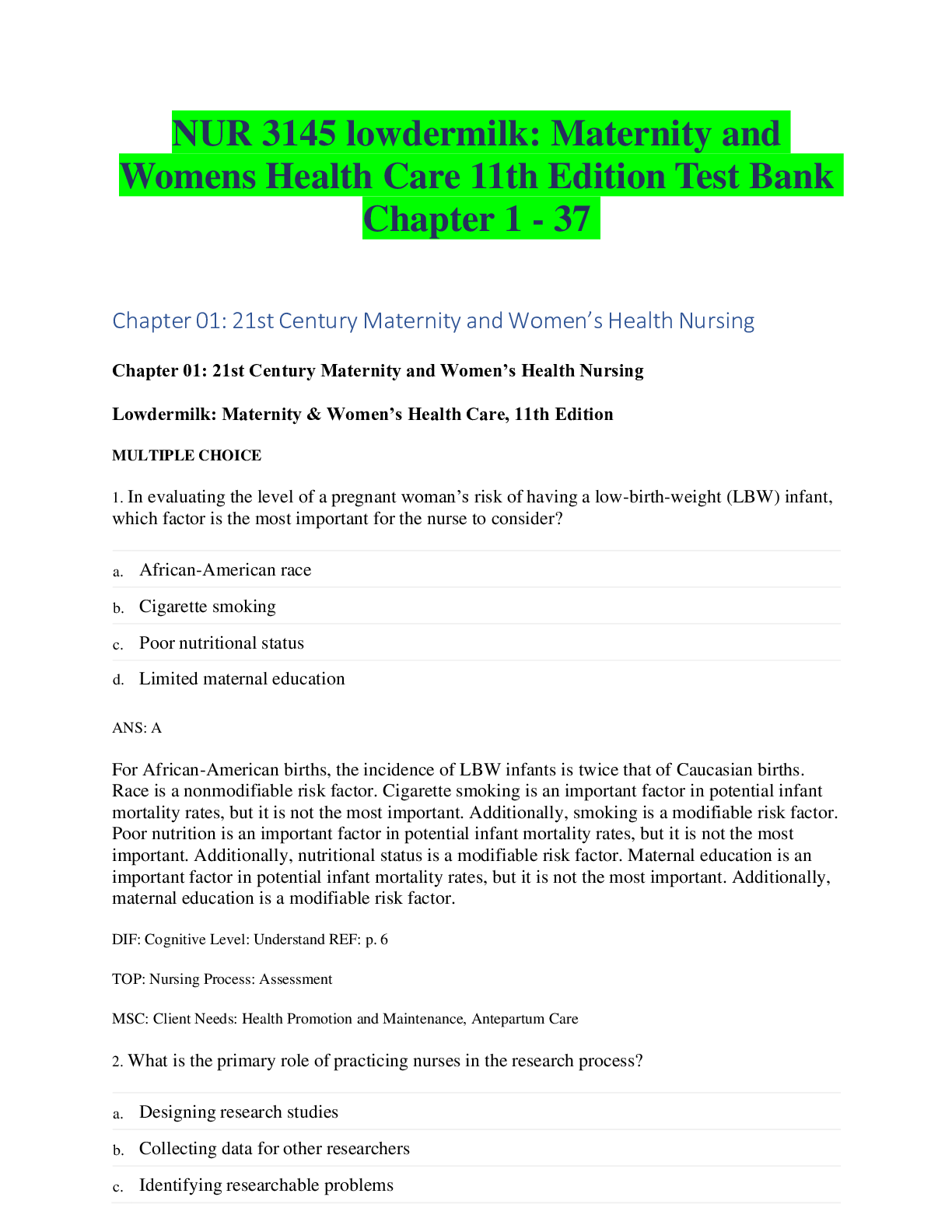RN ATI Capstone Maternal Newborn and Women's Health
Document Content and Description Below
RN ATI Capstone Maternal Newborn and Women's Health RN ATI Capstone Maternal Newborn and Women's Health 2016 Health Promotion and Maintenance - (12) Cancer Disorders: Risk Factors for Ovari... an Cancer (Active Learning Template - System Disorder, RM AMS RN 10.0 Chp 92) Age greater than 40 years Nulliparity or first pregnancy after 30 years of age Family history of ovarian, breast, or genetic mutation for hereditary nonpolyposis colon cancer (HNPCC) BRCA1 or BRCA2 gene mutations Diabetes mellitus Early menarche/late menopause History of dysmenorrhea or heavy bleeding Endometriosis High-fat diet (possible risk) Hormone replacement therapy Use of infertility medications Older adult clients following surgery for cancer Contraception: Contraindication to Intrauterine Device (Active Learning Template - Basic Concept, RM MN RN 10.0 Chp 1) RISKS/CONTRAINDICATIONS Best used by women in a monogamous relationship due to the risks of STIs Can cause irregular menstrual bleeding Risk of bacterial vaginosis, uterine perforation, or uterine expulsion Must be removed in the event of pregnancy CONTRA-INDICATIONS: Active pelvic infection, abnormal uterine bleeding, severe uterine distortion; for copper IUD also Wilson’s diseases and copper allergy Contraception: Evaluating Client Understanding of an Intrauterine Device (Active Learning Template - Medication, RM MN RN 10.0 Chp 1) A chemically active T-shaped device that is inserted through the cervix and placed in the uterus by the provider. Releases a chemical substance that damages sperm in transit to the uterine tubes and prevents fertilization. The most effective contraceptive methods at preventing pregnancy are the long acting reversible contraceptive (LARC) methods: implant and IUDs. IUDs can be used by nulliparous and multiparous women. CLIENT EDUCATION: The device must be monitored monthly by clients after menstruation to ensure the presence of the small string that hangs from the device into the upper part of the vagina to rule out migration or expulsion of the deviceExpected Physiological Changes During Pregnancy: Identifying a Client's Obstetrical History (Active Learning Template - Basic Concept, RM MN RN 10.0 Chp 3) Reproductive Uterus increases in size and changes shape and position. Ovulation and menses cease during pregnancy. Cardiovascular Cardiac output increases (30% to 50%) and blood volume increases (30% to 45% at term) to meet the greater metabolic needs. Heart rate increases during pregnancy beginning around week 5 and reaches a peak (10to15/min above pre-pregnancy rate) around 32weeks of pregnancy. Respiratory Maternal oxygen needs increase. During the last trimester, the size of the chest might enlarge, allowing for lung expansion, as the uterus pushes upward. Respiratory rate increases and total lung capacity decreases. Musculoskeletal Body alterations and weight increase necessitate an adjustment in posture. Pelvic joints relax. Gastrointestinal Nausea and vomiting might occur due to hormonal changes and/or an increase of pressure within the abdominal cavity as the pregnant client’s stomach and intestines are displaced within the abdomen. Constipation might occur due to increased transit time of food through the gastrointestinal tract and, thus, increased water absorption. Renal Filtration rate increases secondary to the influence of pregnancy hormones and an increase in blood volume and metabolic demands. The amount of urine produced remains the same. Urinary frequency is common during pregnancy. Endocrine The placenta becomes an endocrine organ that produces large amounts of hCG, progesterone, estrogen, human placental lactogen, and prostaglandins. Hormones are very active during pregnancy and function to maintain pregnancy and prepare the body for delivery Infections: Caring for a Client in Labor Who Had a Positive Group B Streptococcus Screen (Active Learning Template - System Disorder, RM MN RN 10.0 Chp 8) Administer intrapartum antibiotic prophylaxis to the following clients. Client who has GBS bacteriuria during current pregnancy Client who has a GBS-positive screening during current pregnancy Client who has unknown GBS status who is delivering at less than 37 weeks of gestation Client who has maternal fever of 38° C (100.4° F) Client who has rupture of membranes for 18 hr or longer Infertility: Risk Factors Affecting Fertility (Active Learning Template - Basic Concept, RM MN RN 10.0 Chp 2) ASSESSMENT Female AGE: Age greater than 35 years can affect fertility. DURATION OF INFERTILITY: More than 1 year of coitus without contraceptives. For women over the age 35 or who have a known risk factor, the recommendation is for 6months.MEDICAL HISTORY: Atypical secondary sexual characteristic, such as abnormal body fat distribution or hair growth, is indicative of an endocrine disorder. Assessment should include hormonal and adrenal gland disorders, as these can contribute to infertility. SURGICAL HISTORY: Particularly pelvic and abdominal procedures. OBSTETRIC HISTORY: Past episodes of spontaneous abortions. Other obstetric assessments should include an evaluation of hormone levels throughout the client’s cycle. This can provide information about anovulation, amenorrhea, and premature ovarian failure. GYNECOLOGIC HISTORY: Abnormal uterine contours or any history of disorders that can contribute to the formation of scar tissue that can cause blockage of ovum or sperm. SEXUAL HISTORY: Intercourse frequency, number of partners across the lifespan, and any history of STIs Labor and Delivery Processes: Behaviors During Latent Stage of Labor (Active Learning Template - Basic Concept, RM MN RN 10.0 Chp 11) Contractions Irregular, mild to moderate Frequency: 5 to 30 min Duration: 30 to 45 seconds Newborn Nutrition: Storage of Breast Milk (Active Learning Template - Basic Concept, RM MN RN 10.0 Chp 25) Breast milk can be stored at room temperature under very clean conditions for up to 8 hr. It can be refrigerated in sterile bottles for use within 8 days, or can be frozen in sterile containers in the freezer compartment of a refrigerator for up to 6months. Breast milk can be stored in a deep freezer for 12 months. Thawing the milk in the refrigerator for 24 hr is the best way to preserve the immunoglobulins present in it. It also can be thawed by holding the container under running lukewarm water or placing it in a container of lukewarm water. The bottle should be rotated often, but not shaken when thawing in this manner. Thawing by microwave is contraindicated because it destroys some of the immune factors and lysozymes contained in the milk. Microwave thawing also leads to the development of hot spots in the milk because of uneven heating, which can burn the newborn. Do not refreeze thawed milk. Used portions of breast milk must be discarded Nursing Care and Discharge Teaching: Care of a Newborn Who Is Uncircumcised (Active Learning Template - Basic Concept, RM MN RN 10.0 Chp 26) Remove the newborn from the restraining board, and swaddle to provide comfort. Monitor for bleeding and voiding per facility protocol. Apply gauze lightly to penis if bleeding or oozing is observed. Fan-fold diapers to prevent pressure on the circumcised area.Liquid acetaminophen 10 to 15 mg/kg can be administered orally after the procedure and repeated every 4 to 6 hr as prescribed for a maximum of 30 to 45mg/kg/day Nursing Care During Stages of Labor: Interventions During the Third Stage of Labor (Active Learning Template - Basic Concept, RM MN RN 10.0 Chp 14) Lasts from the birth of the fetus until the placenta is delivered Nursing Care During Stages of Labor: Transition Stage of Labor (Active Learning Template - Basic Concept, RM MN RN 10.0 Chp 14) DURING THE TRANSITION PHASE Continue to encourage voiding every 2 hr. Continue to monitor and support the client and fetus. Encourage a rapid pant-pant-blow breathing pattern if the client has not learned a particular breathing pattern. Discourage pushing efforts until the cervix is fully dilated. Listen for client statements expressing the need to have a bowel movement. This sensation is a finding of complete dilation and fetal descent. Prepare the client for the birth. Observe for perineal bulging or crowning (appearance of the fetal head at the perineum). Encourage the client to begin bearing down with contractions once the cervix is fully dilated Nutrition During Pregnancy: Client Teaching About Dietary Intake (Active Learning Template - Basic Concept, RM MN RN 10.0 Chp 5) Increase calories: An increase of 340 calories/day is recommended during the second trimester. An increase of 462calories/day is recommended during the third trimester. If the client is breastfeeding during the postpartum period, additional caloric intake is advised. The American Academy of Pediatrics (AAP) recommends that breastfeeding women who are well nourished should add 450 to 500 calories/day to a balanced diet. Increasing protein intake is essential to basic growth. Also, the intake of foods high in folic acid is crucial for neurological development and the prevention of fetal neural tube defects. Foods high in folic acid include leafy vegetables, dried peas and beans, seeds, and orange juice. Breads, cereals, and other grains are fortified with folic acid. The March of Dimes recommends that clients who wish to become pregnant and clients of childbearing age take 400 mcg of folic acid .and clients who become pregnant take 600 mcg of folic acid. Iron supplements are often added to the prenatal plan to facilitate an increase of the maternal RBC mass. Iron is best absorbed between meals and when given with a source of vitamin C. Milk and caffeine interfere with the absorption of iron supplements. Food sources of iron include beef liver, red meats, fish, poultry, dried peas and beans, and fortified cereals and breads. A stool softener might need to be added to decrease constipation experienced with iron supplements. Calcium, which is important to a developing fetus, is involved in bone and teeth formation. Sources of calcium include milk, calcium-fortified soy milk, fortified orange juice, nuts, legumes,and dark green leafy vegetables. Daily recommendation is 1,000 mg/day for pregnant and nonpregnant women 19 to 50 years of age, and 1,300 mg/day for those under 19 years of age. Fluid: 8 to 10 glasses (2.3 L) of fluid are recommended daily. Preferred fluids are water, fruit juice, and milk. Limit caffeine: The American Congress of Obstetricians and Gynecologists (ACOG) and March of Dimes recommend a daily intake of no more than 200 mg of caffeine. The equivalent of 500 to 750mL/day of coffee could increase the risk of a spontaneous abortion or fetal intrauterine growth restriction. It is recommended that women abstain from alcohol consumption during pregnancy. Disorders of Female Reproductive Tissue: Client Teaching About Fibrocystic Breast Changes (Active Learning Template - System Disorder, RM AMS RN 10.0 Chp 64) Breast pain Tender lumps, commonly in upper, outer quadrant PHYSICAL ASSESSMENT FINDINGS: Palpable rubber like lumps, usually in the upper, outer quadrant Pharmacological and Parenteral Therapies - (9) Pain Management: Adverse Effects of an Epidural (Active Learning Template - Therapeutic Procedure, RM MN RN 10.0 Chp 12) ADVERSE EFFECTS Decreased gastric emptying resulting in nausea and vomiting Inhibition of bowel and bladder elimination sensations Bradycardia or tachycardia Hypotension Respiratory depression Allergic reaction and pruritus Elevated temperature Cancer Disorders: Identifying Indication for Taking Tamoxifen (Active Learning Template - Medication, RM AMS RN 10.0 Chp 92) Selective estrogen receptor modulators (SERMs): toremifene (tamoxifen and raloxifene) Used in women who are at high risk for breast cancer or who have advanced breast cancer. Suppress the growth of remaining cancer cells postmastectomy or lumpectomy. Tamoxifen has been found to increase the risk of endometrial cancer, deep-vein thrombosis, and pulmonary embolism. Raloxifene does not share these adverse effects. Immunizations: Contraindication to Rubella Immunization (Active Learning Template - Medication, RM Pharm RN 7.0 Chp 41) CONTRAINDICATION: Pregnancy PRECAUTIONSHistory of thrombocytopenia or thrombocytopenic purpura Anaphylactic reaction to eggs, gelatin, or neomycin Transfusion with blood product containing antibodies within the prior 11 months Simultaneous tuberculin skin testing Infections: Identifying Medication Used to Treat Streptococcus ß-Hemolytic Infection (Active Learning Template - System Disorder, RM MN RN 10.0 Chp 8) Penicillin G or ampicillin are most commonly prescribed for GBS. Administer penicillin 5 million units initially IV bolus, followed by 2.5 million units intermittent IV bolus every 4 hr. The client may receive ampicillin 2 g IV initially, followed by 1 g every 4 hr. Bactericidal antibiotic is used to destroy the GBS Medications Affecting the Reproductive Tract: Client Teaching About Estrogen Replacement Therapy (Active Learning Template - Medication, RM Pharm RN 7.0 Chp 31) EXPECTED PHARMACOLOGICAL ACTION Estrogens are hormones needed for growth and maturation of the female reproductive tract, development of secondary sex characteristics, and are active in the follicular phase of the menstrual cycle. Estrogens block bone resorption and reduce low-density lipoprotein (LDL) levels. At high levels, estrogens suppress the release of a follicle-stimulating hormone (FSH) needed for conception. Estrogens also can promote or suppress blood coagulation Nonopioid Analgesics: Assessments Prior to Administration of Ibuprofen (Active Learning Template - Medication, RM Pharm RN 7.0 Chp 35 Advise clients to stop aspirin 1 week before an elective surgery or expected date of childbirth. Advise clients to take NSAIDs with food, milk, or an 8oz glass of water to reduce gastric discomfort. Instruct clients not to chew or crush enteric-coated or sustained-release aspirin tablets. Advise clients to notify the provider if manifestations of gastric discomfort or ulceration occur. Advise clients to notify the provider if manifestations of salicylism occur. The medication should be discontinued until manifestations are resolved. The medication can be restarted at a lower dose. Ketorolac can be used for short-term treatment of moderate to severe pain such as that associated with postoperative recovery. Concurrent use with opioids allows for lower dosages of opioids and thus minimizes adverse effects such as constipation and respiratory depression. Ketorolac is usually first administered parenterally and then switched to oral doses. Use should not be longer than 5 days because of the risk for kidney damage Postpartum Disorders: Actions to Take for Excessive Postpartum Vaginal Bleeding (Active Learning Template - System Disorder, RM MN RN 10.0 Chp 20)Postpartum hemorrhage is considered to occur if the client loses more than 500 mL blood after a vaginal birth or more than 1,000 mL blood after a cesarean birth. Two complications that can occur following postpartum hemorrhage include hypovolemic shock and anemia Firmly massage the uterine fundus. Monitor vital signs. Assess for source of bleeding. Assess fundus for height, firmness, and position. If uterus is boggy, massage fundus to increase muscle contraction. Assess lochia for color, quantity, and clots. Assess for clinical findings of bleeding from lacerations, episiotomy site, or hematomas. Assess bladder for distention. Insert an indwelling urinary catheter to assess kidney function and obtain an accurate measurement of urinary output. Maintain or initiate IV fluids to replace fluid volume loss with IV isotonic solutions, such as lactated Ringer’s or 0.9% sodium chloride; colloid volume expanders, such as albumin; and blood products (packed RBCs and fresh frozen plasma). Provide oxygen at 2 to 3 L/min per nasal cannula, and monitor oxygen saturation. Elevate the client’s legs to a 20° to 30° angle to increase venous return Reduction of Risk Potential - (3) Assessment and Management of Newborn Complications: Monitoring a Newborn's Blood Glucose (Active Learning Template - System Disorder, RM MN RN 10.0 Chp 27) Obtain blood by heel stick for glucose monitoring. An asymptomatic at-risk newborn who has a blood glucose level 25 mg/dL in the first 4 hr, or less than 35 mg/dL from 4 hr to 24 hr of age, should be offered oral feedings to increase levels to greater than 45 mg/dL. Initiate IV dextrose for a symptomatic newborn. Provide frequent oral and/or gavage feedings or continuous parenteral nutrition early after birth to treat hypoglycemia. Monitor the neonate’s blood glucose level closely per facility protocol. Monitor IV if the neonate is unable to feed orally. Maintain skin-to-skin contact to treat hypothermiaDiagnostic and Therapeutic Procedures for Female Reproductive Disorders: Client Teaching About Papanicolaou (Pap) Test (Active Learning Template - Basic Concept, RM AMS RN 10.0 Chp 62) Bimanual examination of the cervix, uterus, fallopian tubes, and ovaries is performed by the provider. The provider inserts two gloved fingers into the vagina and traps the reproductive structures between the fingers of the one hand and the fingers of the opposite hand that is on the abdomen. Palpation of the structures is done during this time. Two tests are used for cervical cancer screening, the Papanicolaou (Pap) test and the test for human papilloma virus (HPV). Both can be performed prior to the pelvic examination. The Pap test is use to identify precancerous and cancerous cells of the cervix. The HPV test is used to identify HPV infections that can lead to cervical cancer Fetal Assessment During Labor: Early Decelerations of the Fetal Heart Rate (Active Learning Template - Basic Concept, RM MN RN 10.0 Chp 13) Slowing of FHR with start of contraction with return of FHR to baseline at end of contraction CAUSES/COMPLICATIONS Compression of the fetal head resulting from uterine contraction Uterine contractions Vaginal exam Fundal pressure NURSING INTERVENTIONS: No intervention required Physiological Adaptation - (2) Infections: Plan of Care for a Client Who Has an Active Varicella-Zoster Infection (Active Learning Template - System Disorder, RM MN RN 10.0 Chp 8) Labor and Delivery Processes: Administering Pain Medication to a Client Who Reports the Need to Have a Bowel Movement (Active Learning Template - Basic Concept, RM MN RN 10.0 Chp 11)Medical Conditions: Medications for Hyperemesis Gravidarum (Active Learning Template - System Disorder, RM MN RN 10.0 Chp 9) [Show More]
Last updated: 1 year ago
Preview 1 out of 9 pages
Reviews( 0 )
Document information
Connected school, study & course
About the document
Uploaded On
Nov 22, 2022
Number of pages
9
Written in
Additional information
This document has been written for:
Uploaded
Nov 22, 2022
Downloads
0
Views
82
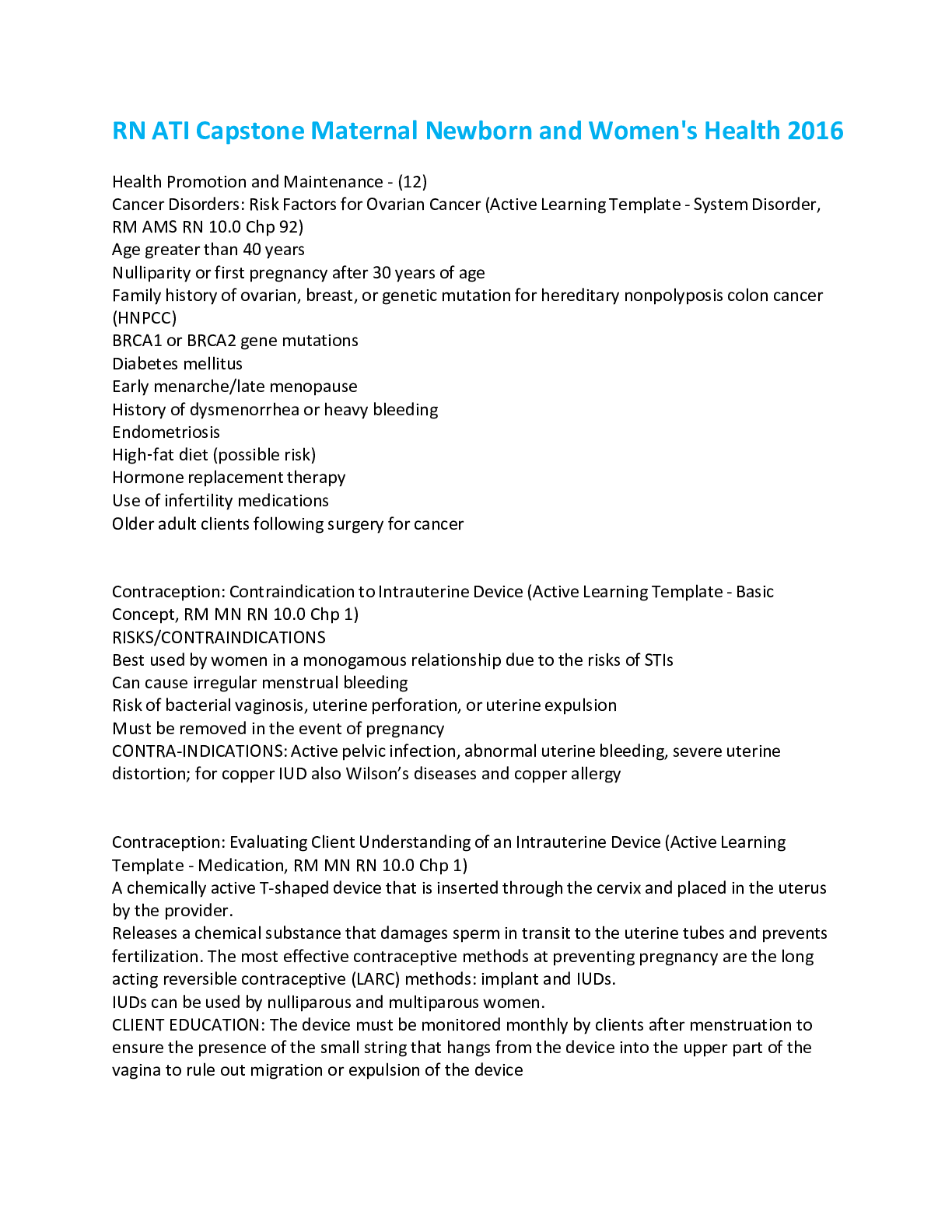



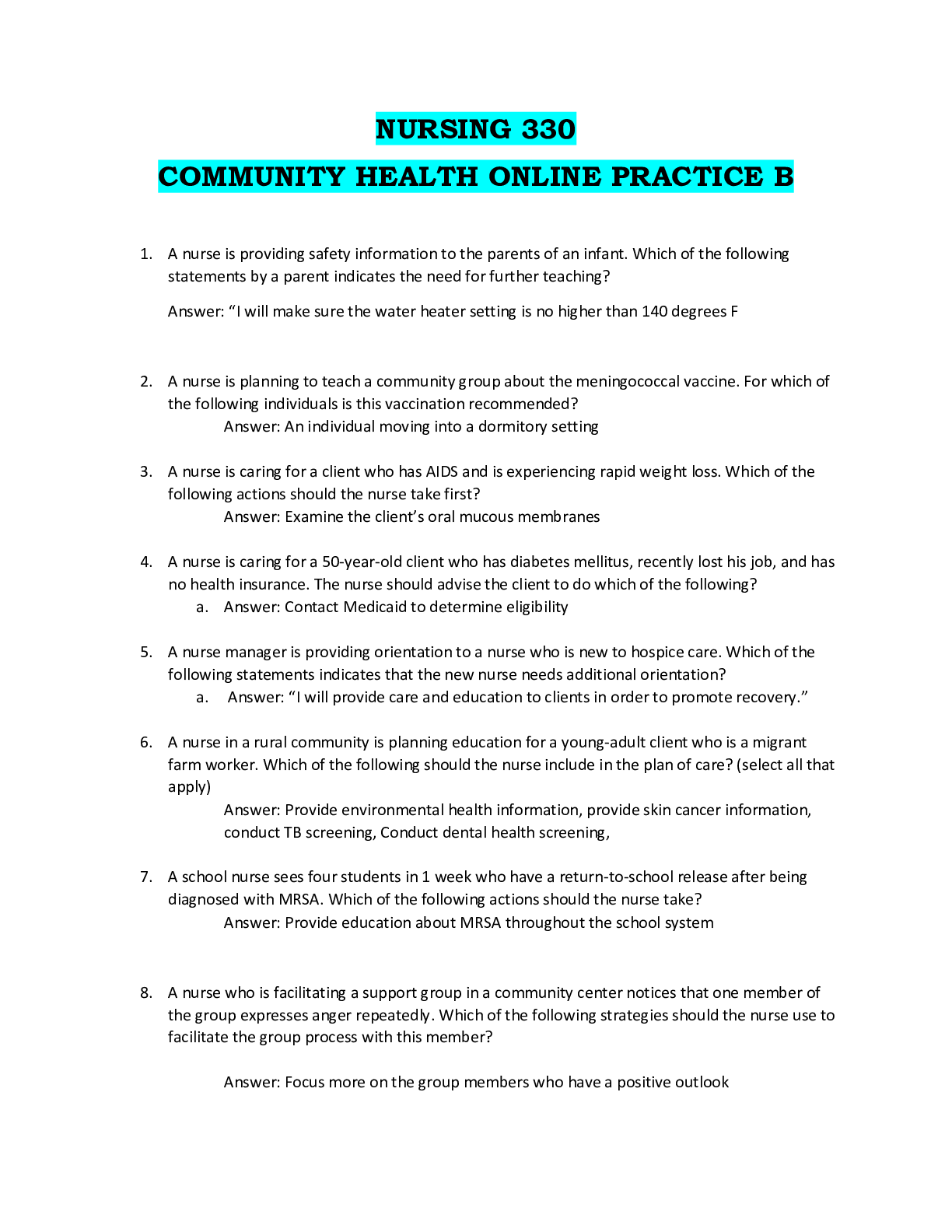

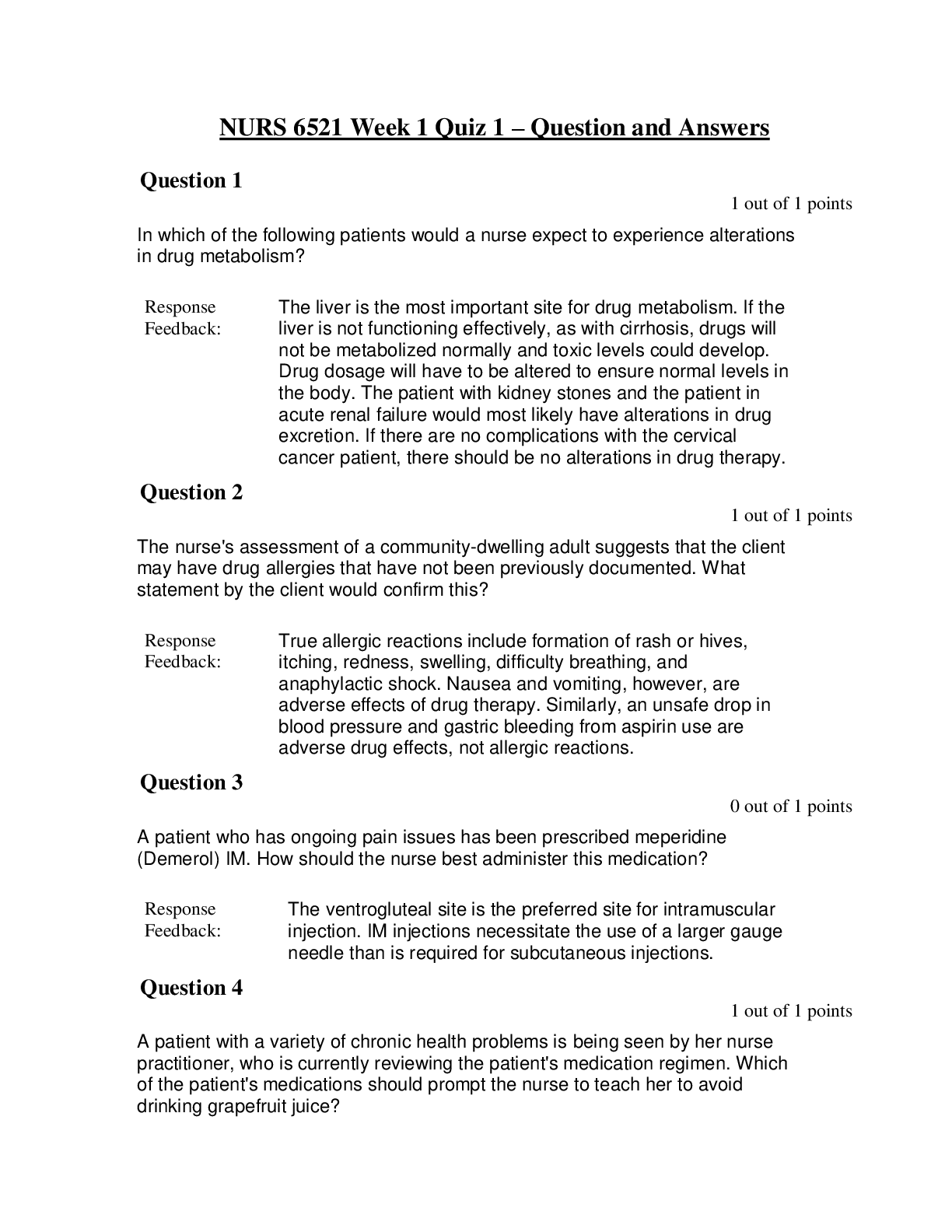

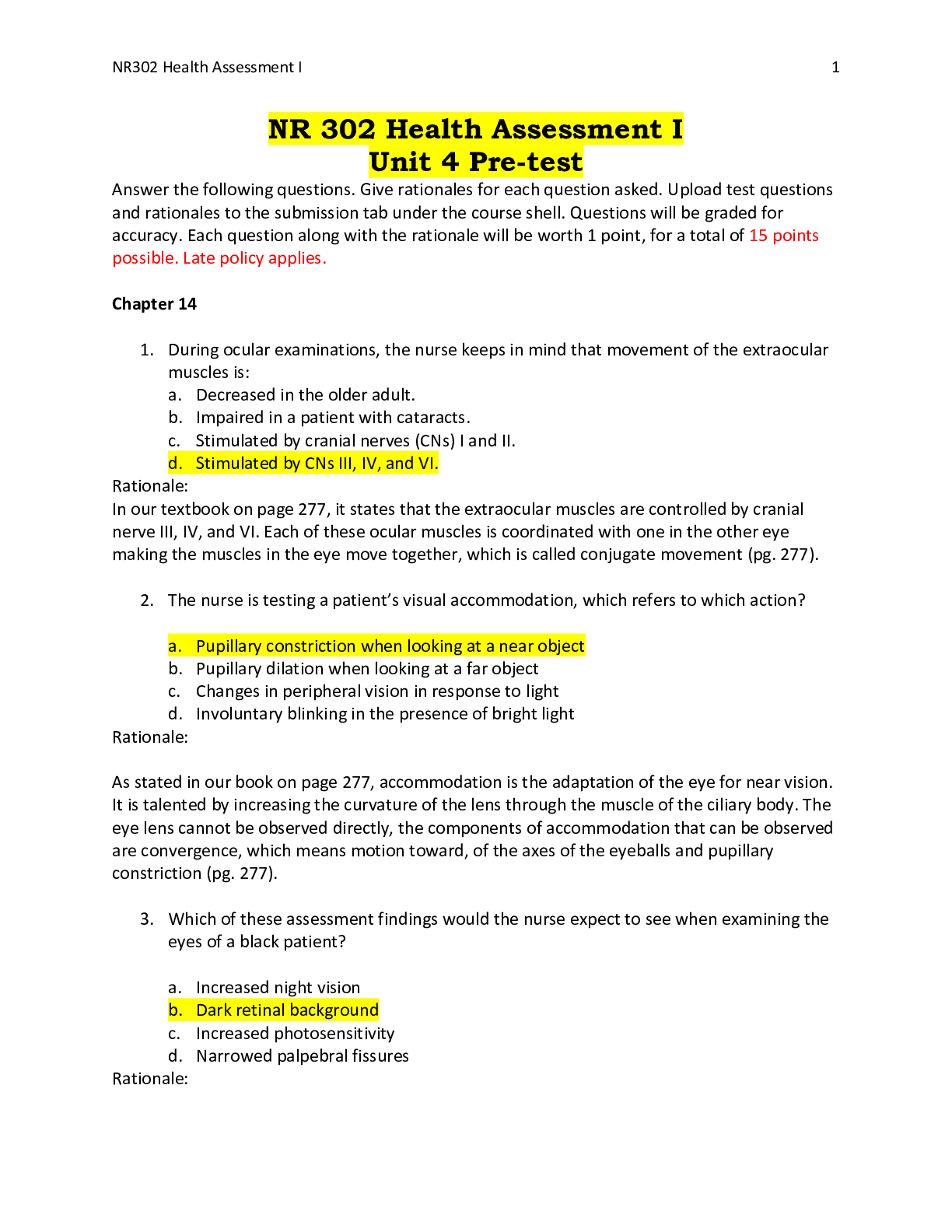



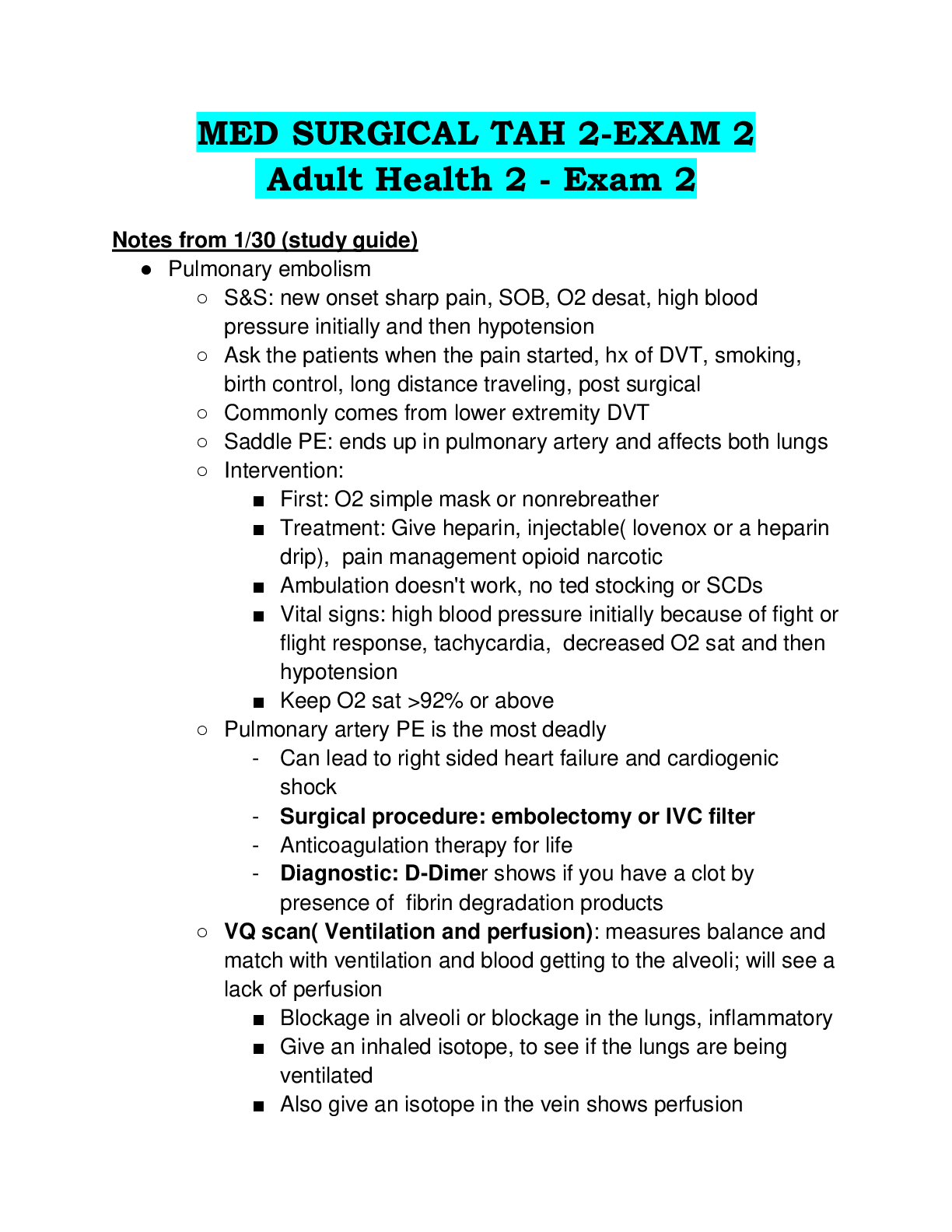

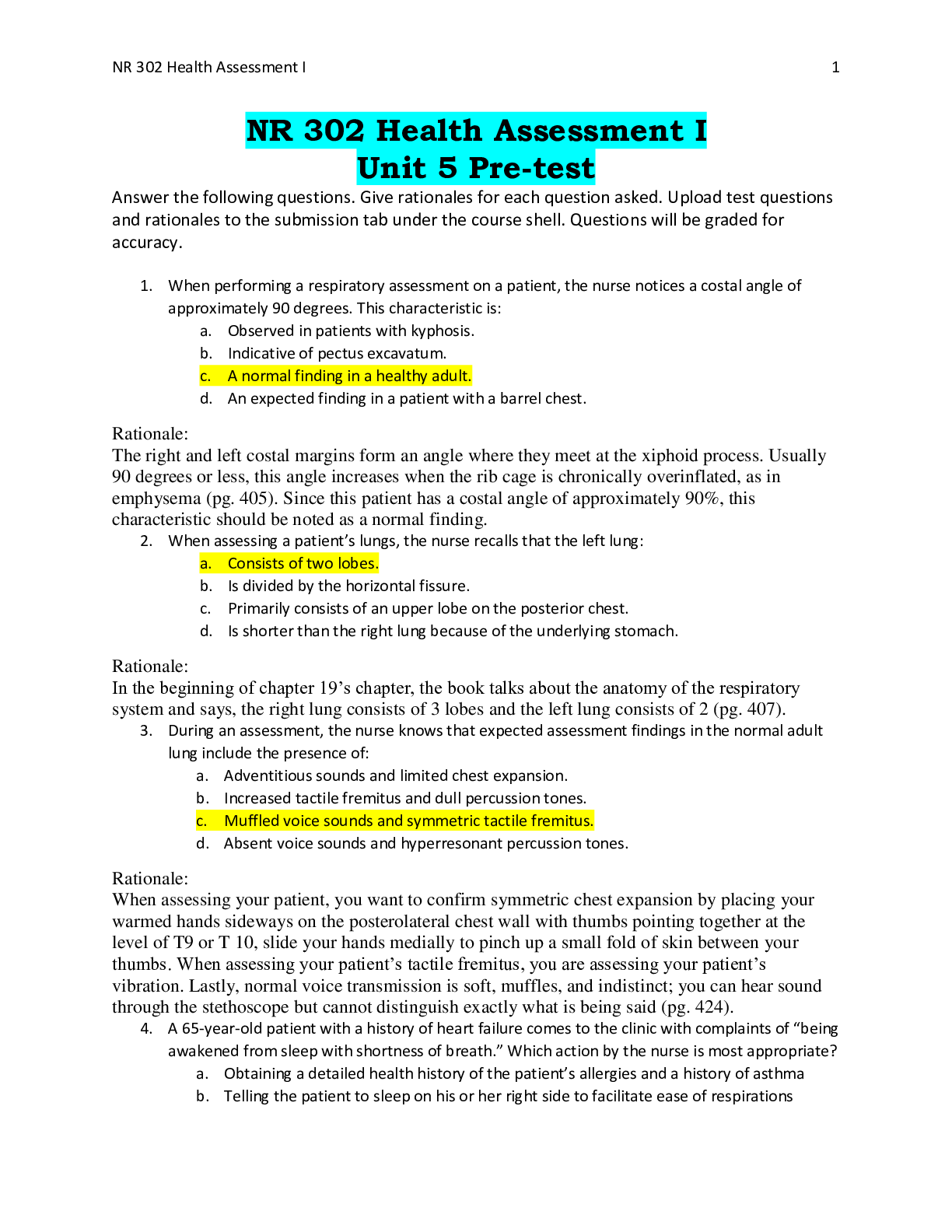

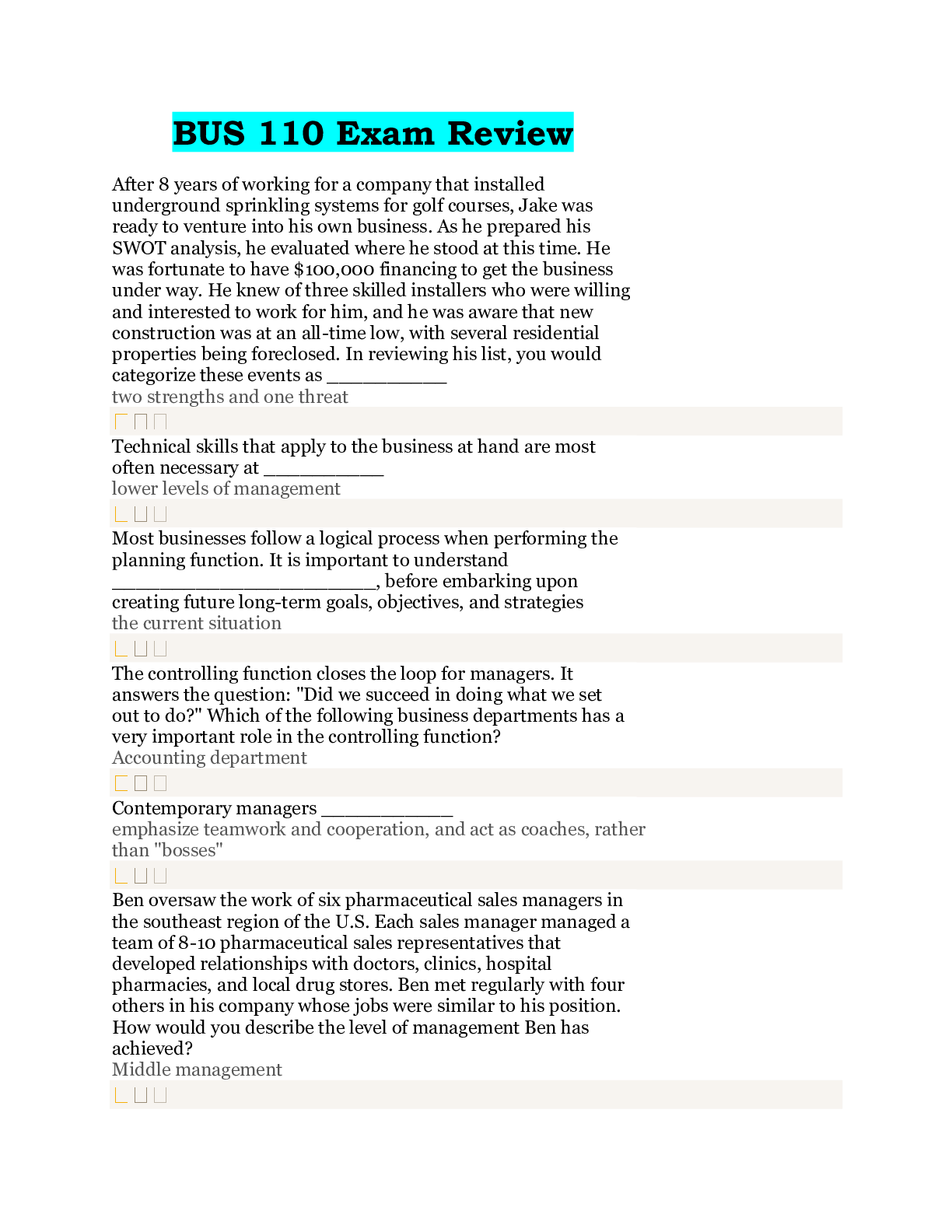
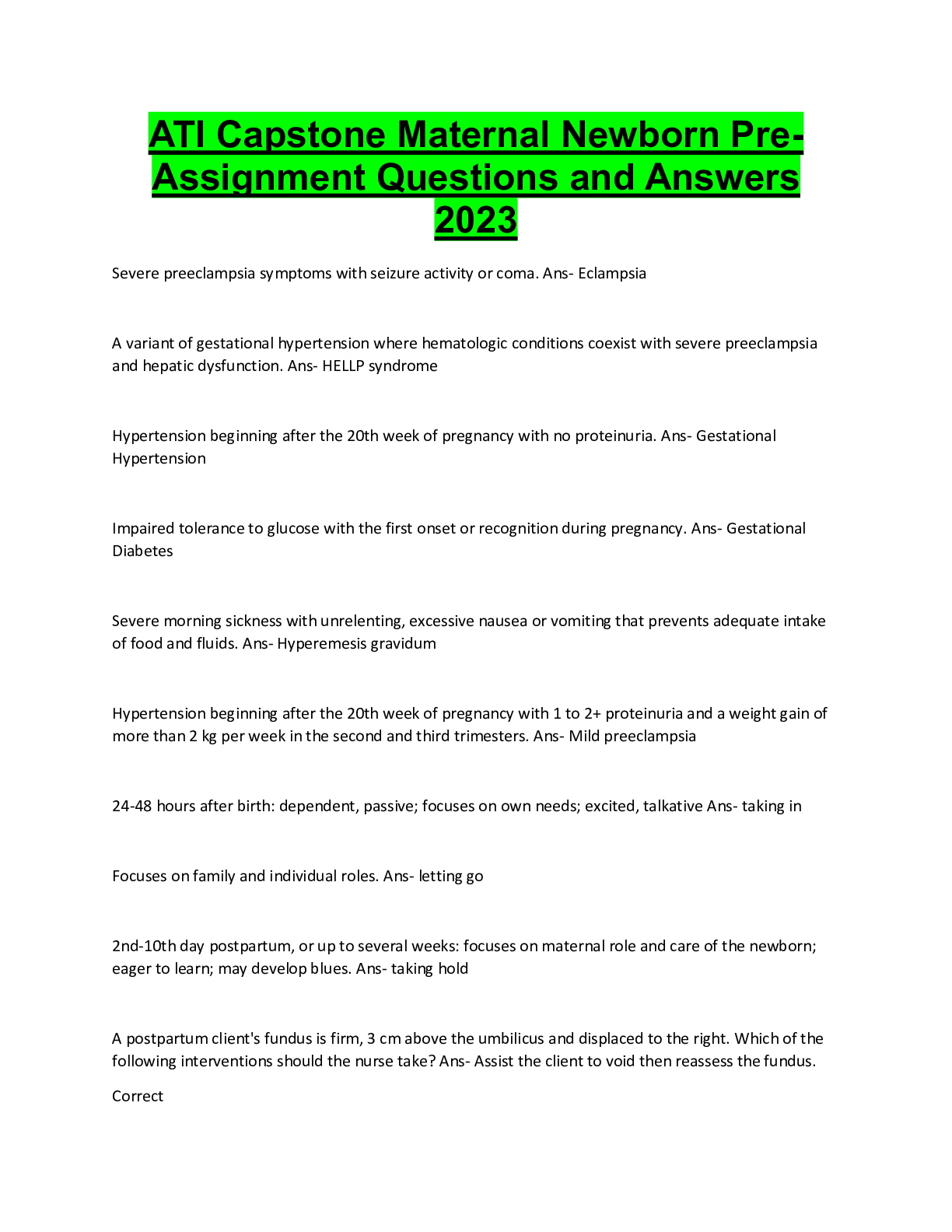
.png)




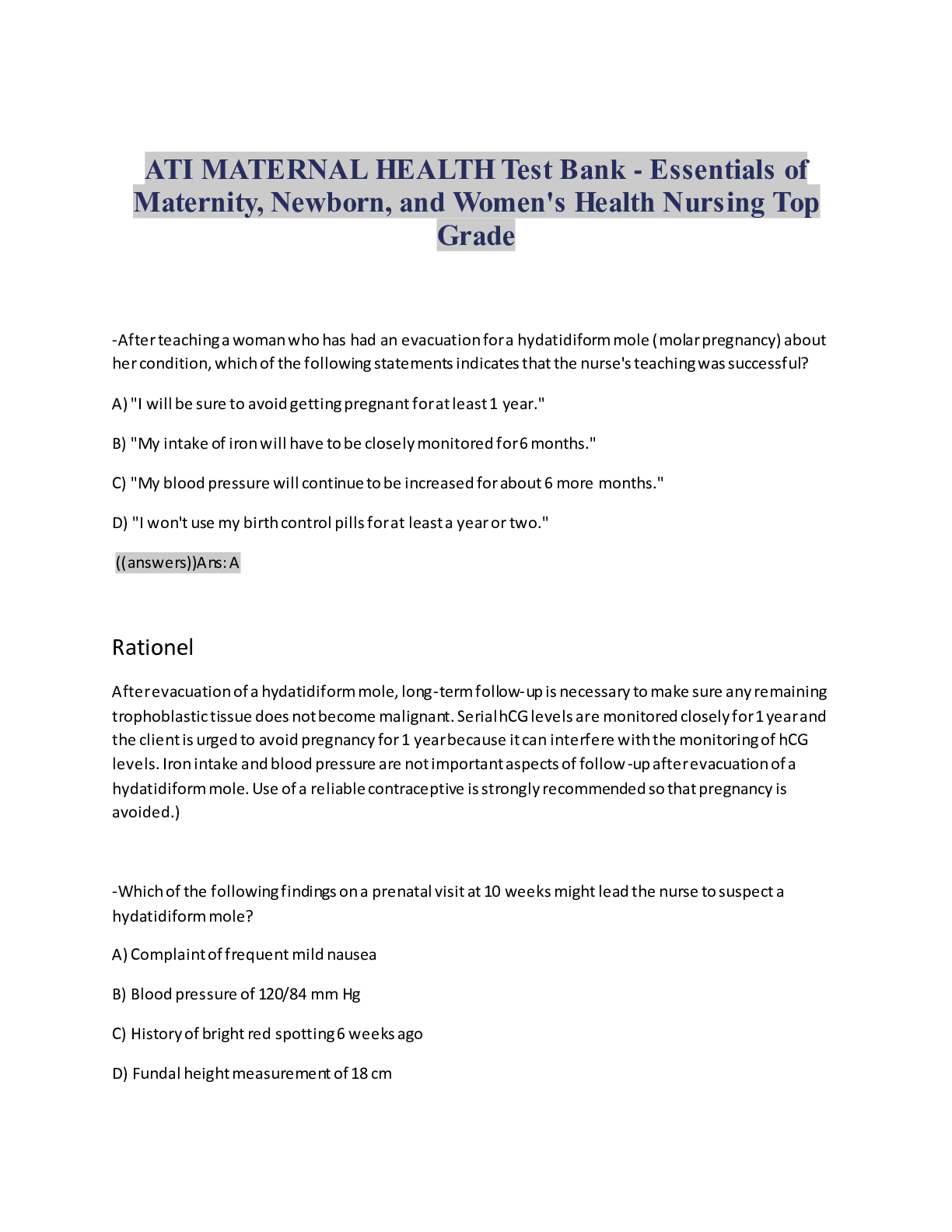
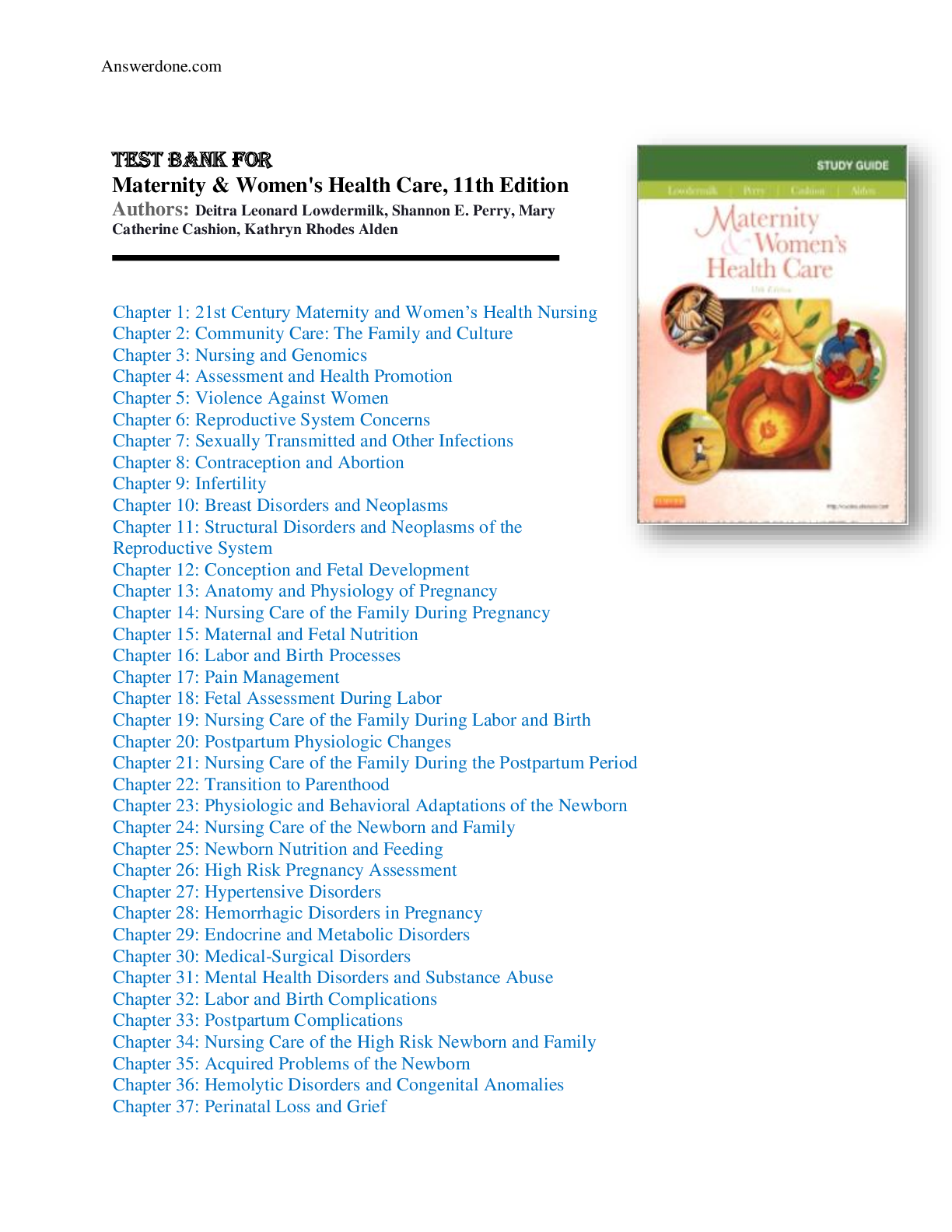

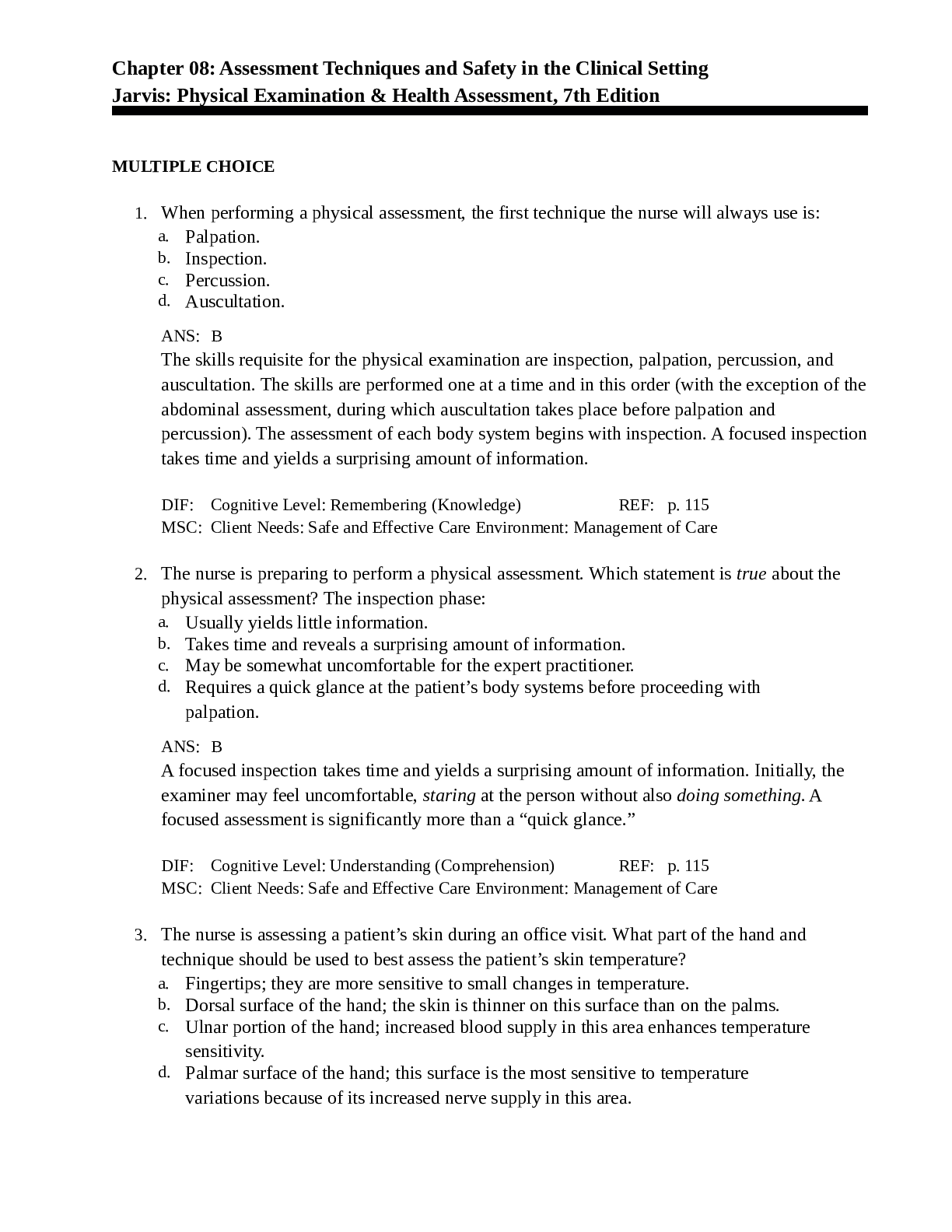
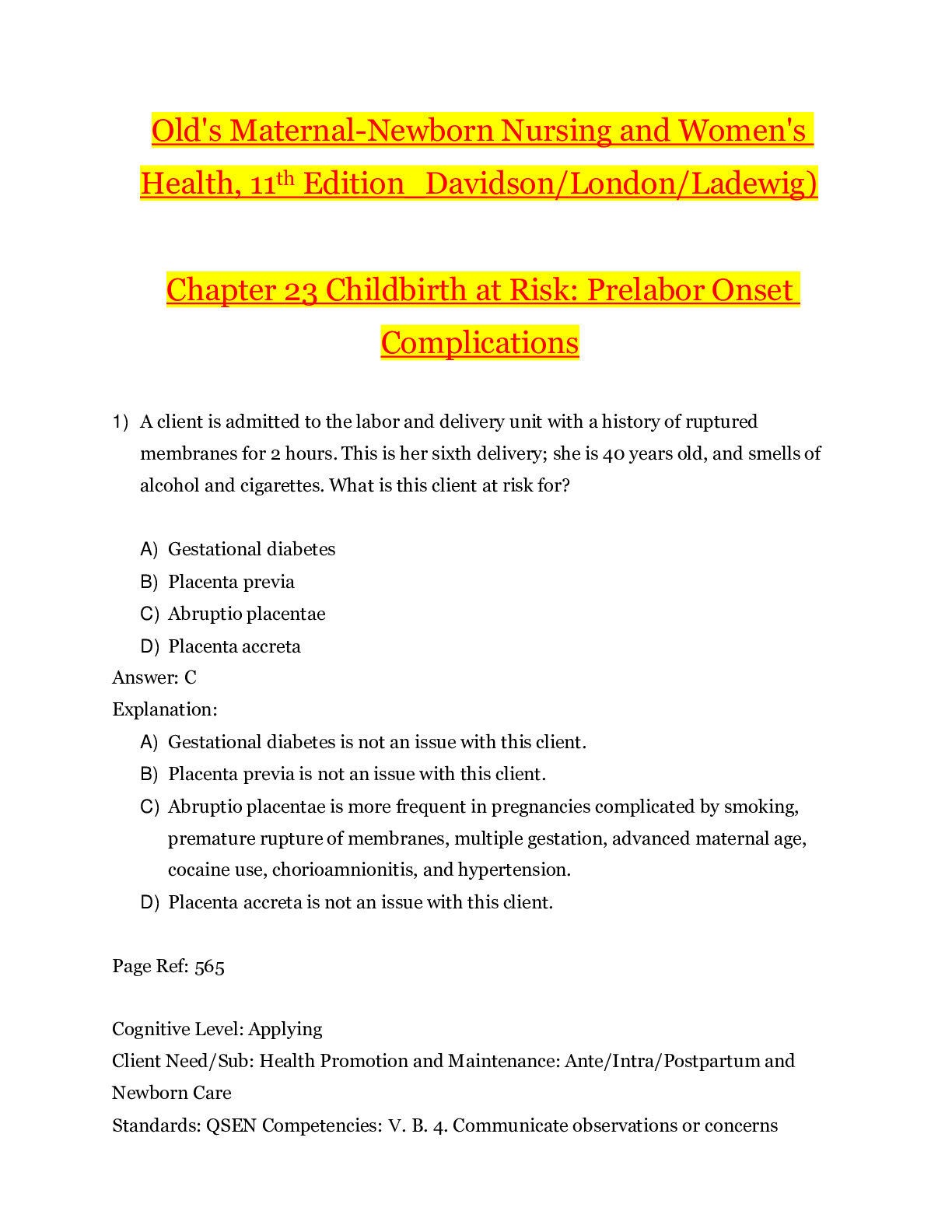
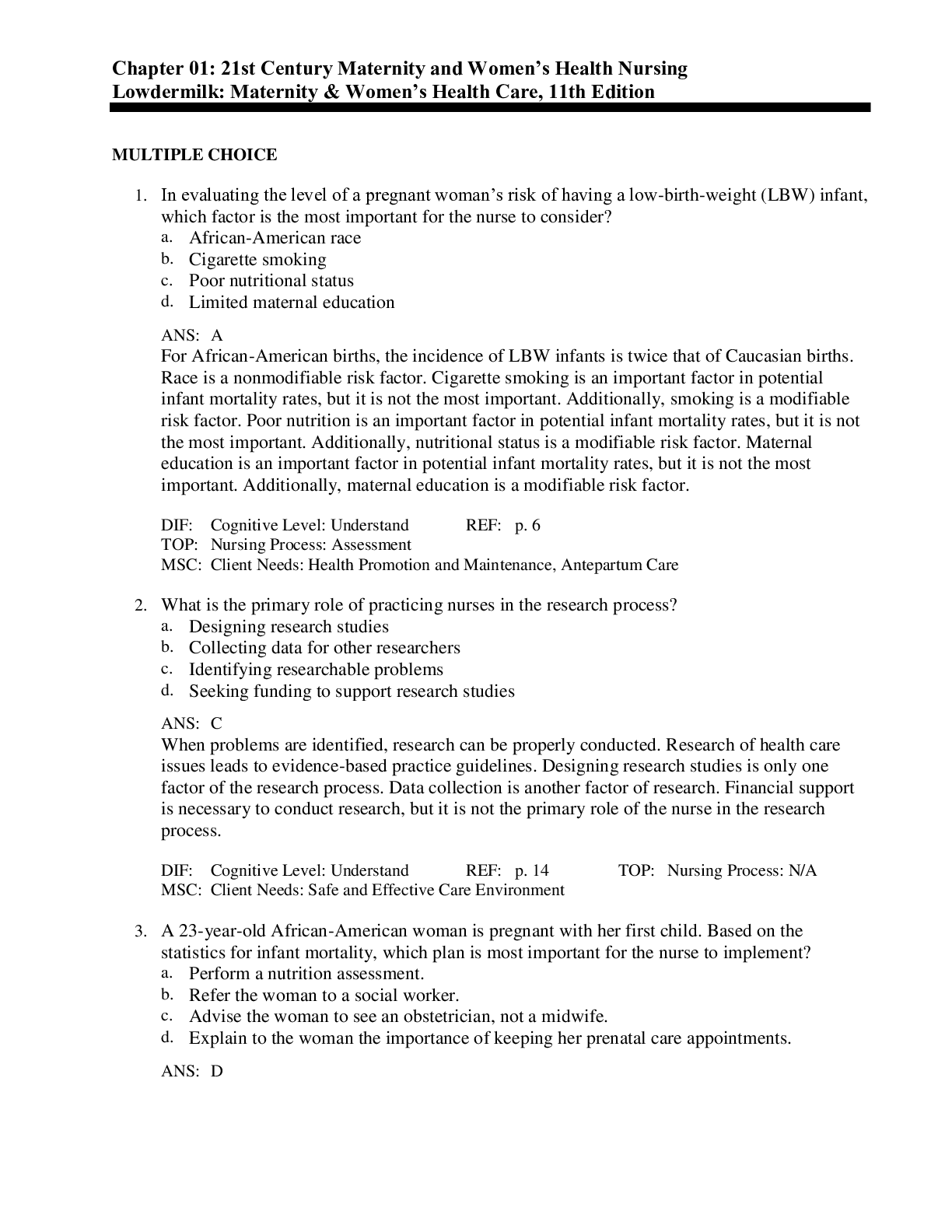
.png)
